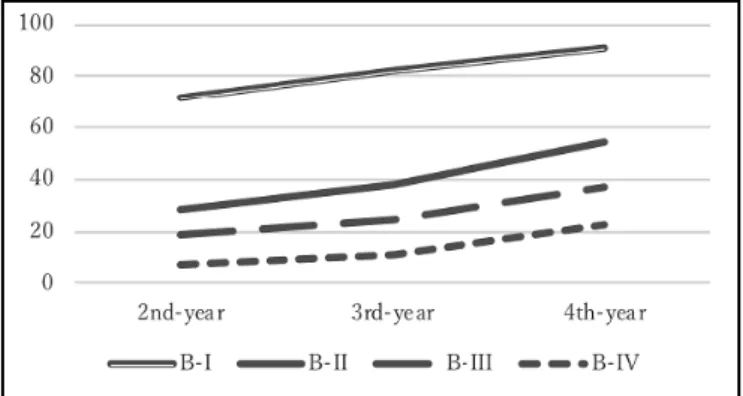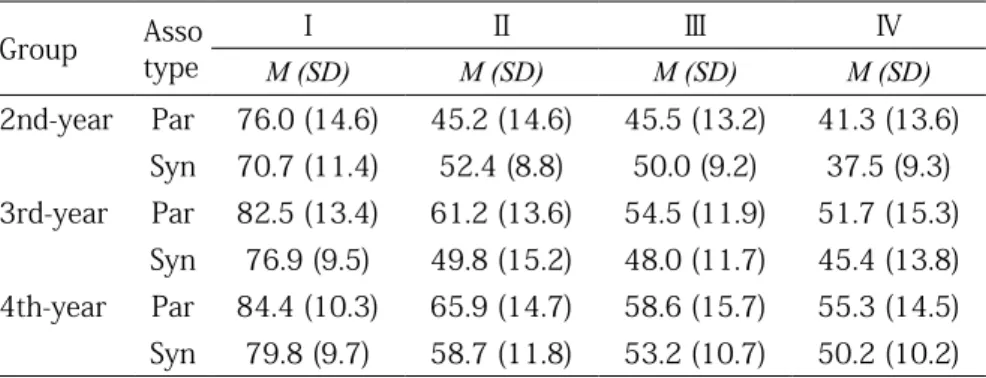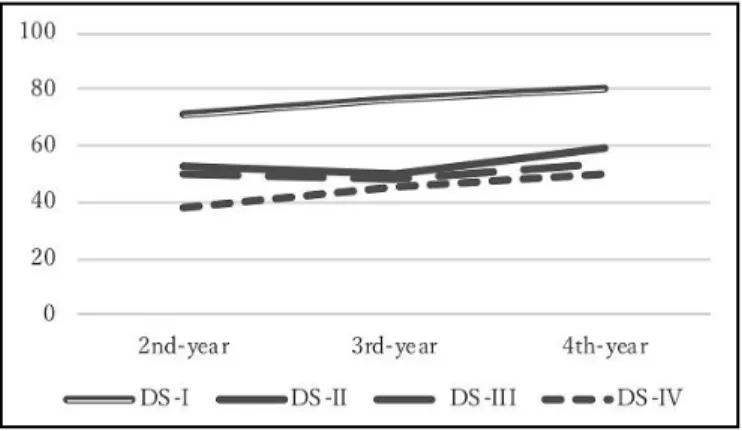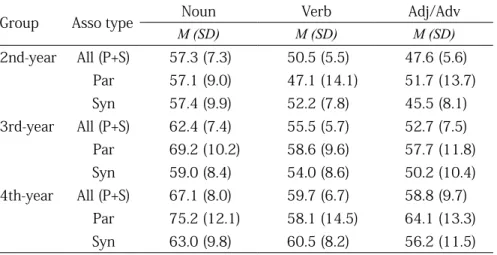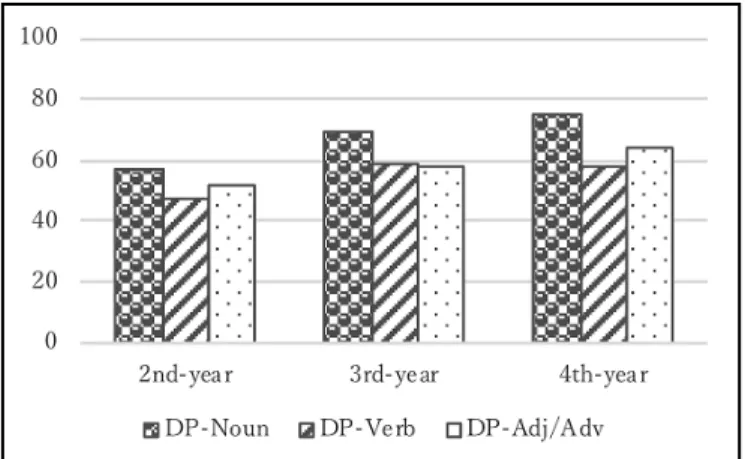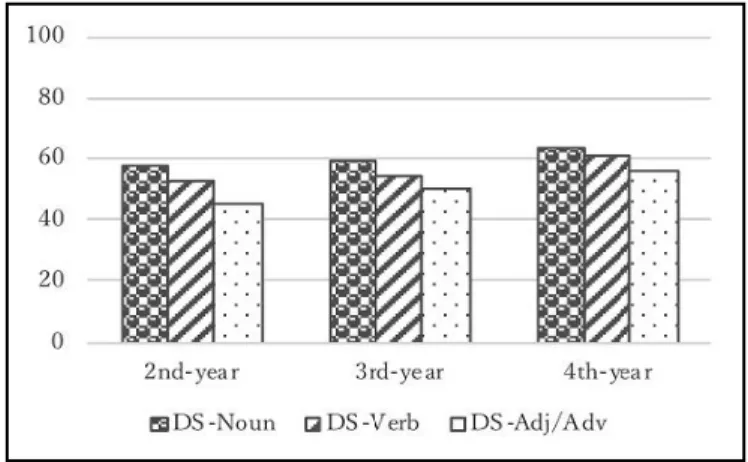Second Language: A Developmental Perspective
journal or
publication title
言語科学研究 : 神田外語大学大学院紀要
number 25
page range 37‑55
year 2019‑03
URL http://id.nii.ac.jp/1092/00001556/
asKUIS 著作権ポリシーを参照のこと
Breadth and Depth of Vocabulary Knowledge in a Second Language: A Developmental Perspective
Yukie Horiba (Kanda University of International Studies) Thanyarat Sanguansri (Burapha University)
Abstract
The present study explores the multidimensionality of word knowledge in a nonnative language (L2) from a developmental perspective. Ninety-one Thai-speaking college students majoring in Japanese as a foreign language (the 2nd-, 3rd- and 4th-year levels) were assessed for breadth (basic word meaning) and depth (paradigmatic and syntagmatic word association) of vocabulary knowledge. The results indicated that breadth and depth of vocabulary grow interrelatedly as individuals have more experiences with the language and that the effect of word frequency is consistent across dimensions and components of knowledge and across levels of language proficiency. The results also suggested that knowledge of nouns develops more easily than knowledge of other word classes in both dimensions and that the relative difficulty of learning verbs and adjectives/adverbs may interact with type of association.
Keywords: breadth and depth of vocabulary, word association, word class, language proficiency, Japanese as a second language
1 .Background
Vocabulary knowledge is critical for language communication. When one attempts to communicate in a non-native language (L2), lack of vocabulary knowledge is commonly experienced by L2 learners/users at all levels of language proficiency. To know a word is not a simple matter but means many different things. Knowledge of a word can be divided into knowledge of its form, its position, its function, and its meaning (Nation, 1990, 2001).
Multidimensionality of vocabulary knowledge is often captured by the distinction between breadth and depth (Meara, 2009; Read, 2000; Wesche
& Paribakht, 1996). Vocabularies can expand in breadth (i.e., the number of words one has some knowledge of) but also in depth (i.e., the quality of what one knows about a word).
Although L2 research into multidimensionality of vocabulary knowledge has accumulated evidence in the field of SLA and applied linguistics, the vast majority of this research is on English. Generalizability of the previous research findings to other languages, especially non-Indo-European languages including Japanese, needs to be tested empirically. The present study aims to investigate the development of breadth and depth of vocabulary knowledge in Japanese for Thai-speaking L2 learners who are at different levels of language proficiency.
Historically speaking, breadth or quantitative dimension of vocabulary knowledge has been a focus of attention among L2 researchers and educational practitioners. Research has shown repeatedly that word frequency influences acquisition and growth of vocabulary knowledge (size) in L1 and L2. Words that are encountered more frequently can be recognized and learned more easily than words that are encountered less frequently.
Words used more frequently can help strengthen the existing knowledge of them or gain new knowledge about them more easily than words used less frequently. In a most-widely known test of vocabulary size in English as L2, the Vocabulary Levels Test (VLT) (Nation, 1990, 2001), target words from different frequency levels are presented and the test-takers are asked to match the target word with its definition in the multiple-choice format. Vocabulary size often correlates with overall language proficiency and thus can be used as estimate of language proficiency (Nagy & Anderson, 1984; Nation, 2001;
Stanovich, 1986).
The depth or qualitative dimension of vocabulary knowledge is defined differently among researchers (Read, 2000; Schmitt, 2000). One useful approach to depth of vocabulary concerns how words are connected to one
another in the associative network knowledge called mental lexicon (Aitchison, 1994). Research with this framework typically employs a word association task, in which the subjects are presented a target word and asked to produce a word that first comes up to mind. Responses are analyzed into categories such as paradigmatic (e.g., table-furniture), syntagmatic (e.g., publish-book), and other (e.g., phonological: donkey-monkey; situational: hospital-doctor).
A receptive word association task is also used in L2 research, in which the subjects are presented a target word and a list of words and asked to select words that are paradigmatically, syntagmatically, or analytically related to the target word (the Word Associates Test: WAT) (Read, 1993, 1998). The format has been adapted in other languages (Greidanus & Nienhuis, 2001; Horiba, 2012).
Research using a productive word association task showed that native speakers have remarkably stable patterns of word association whereas L2 learners produce more unreliable word association. Even advanced learners who are shown to be equivalent to native speakers in terms of vocabulary size may produce associations that are more diverse than and different from the native norms (Nissen & Henriksen, 2006; Wolter, 2001;
Zareva, Schwanenflugel, & Nikolova, 2005). On the other hand, research using a receptive word association task showed that L2 learners tend to prefer paradigmatic responses over syntagmatic responses but that this tendency may also be observed in natives’ performances for low frequency words (Greidanus, Beks, & Wakely, 2005; Greidanus & Nienhuis, 2001).
Some research indicated that rate of development of vocabulary knowledge may differ between L2 learners from different L1 backgrounds even when their levels of reading proficiency are equivalent (Horiba, 2012). Obviously further research is needed to clarify how various factors such as frequency, word class, type of association, level of language proficiency may affect L2 vocabulary development independently and interactively.
The present study was set up to investigate the breadth (i.e., basic word meaning) and depth (i.e., paradigmatic and syntagmatic word association)
of receptive vocabulary knowledge in Japanese as L2 from a developmental perspective. The participants were native speakers of Thai who were enrolled in the 2nd-year, the 3rd-year, and 4th-year level of the same Japanese-as-a- foreign-language program at a university in Thailand. Most of the findings reported in the literature are based on the studies on English as L2 and in many cases dealing with learners from various L1 backgrounds. This study attempts to test the generalizability of the previous findings regarding the target language and the level of language proficiency. The study also examines the interaction between word class and type of word association in order to explore the possible effect of the language distance when the target language is linguistically distant from the learner’s L1.
2.Research questions
The present study was set up to provide some answer to the following question: “How does breadth and depth of vocabulary knowledge in Japanese as L2 develop for L1 Thai-speaking students?” This question can be stated more specifically by using the following subquestions. Does word frequency affect the development of breadth and depth of vocabulary? Does word class affect the development of breadth and depth of vocabulary? Are the effects of frequency and word class similar or different in patterns among leaners at different levels of language proficiency? How are breadth and depth related to each other? Is the relation between breadth and depth similar or different in patterns among leaners at different levels of language proficiency?
3.Method 3.1. Participants
The participants were ninety-one Thai-speaking undergraduate students (77 females and 14 males) who were majoring in Japanese as a foreign language at a national university in Thailand. The number of students enrolled in the 2nd-year, the 3rd-year, and the 4th-year level of the program was 24, 25, and 43, respectively. Originally ninety-three students participated, but the data for
two individuals, one who had lived in Japan for several years and one who did not follow the task instructions, were not used in data analysis.
3.2. Materials
Two vocabulary knowledge tests and a background questionnaire were used in the study. One of the vocabulary tests was designed to assess the breadth dimension of receptive vocabulary knowledge. In the breadth of vocabulary test, the participants were asked to match each target word and its definition in the multiple-choice format (i.e., the format was adapted from the VLT) (Cronbach-α= .95). The other test was designed to assess the depth dimension of vocabulary knowledge. In the depth of vocabulary test the participants were asked to select one paradigmatically related word and two syntagmatically related words for each target word in the multiple-choice format (i.e., the format was adapted from the WAT and adjusted for the study) (Cronbach-α=
.82).
The target words used in the two tests were 156 content words (nouns, verbs, and adjectives/adverbs) from four levels of frequency (Horiba, Matsumoto, Nishi, Yi, & Yamagata, 2010). All items were presented in the written format by using the conventional writing style or using kanji characters (i.e. Chinese characters) and kana syllabaries. All the kanji characters had readings attached in kana syllabaries because the tests were not intended to assess knowledge of kanji.
The background questionnaire was used to elicit basic information about the participant such as age, sex, experiences of foreign language learning and of living overseas.
3.3. Analysis
Responses on the vocabulary tests were scored by using predetermined answer keys. Scores were converted to percentage scores and aggregated into group scores. Group comparisons were conducted on overall test scores only.
Because the developmental patterns were of interest, statistical analyses were
conducted to examine the effect of word frequency, word class, and type of association on vocabulary knowledge and the correlations between different dimensions and components of the knowledge for each group.
4.Results
4.1. Breadth of vocabulary knowledge
The descriptive statistics of the breadth test scores as a function of frequency level and group are presented in Table 1. As expected, the overall scores were highest for the 4th-year group (M = 51.2, SD = 10.1), second highest for the 3rd-year group (M = 38.9, SD = 10.7), and lowest for the 2nd- year group (M = 31.5, SD = 8.6). Descriptively speaking, all groups scored highest for words at the frequency level I (2nd-year: M = 71.9; 3rd-year: M
= 82.1; 4th-year: M = 91.1), dropped sharply for words at the level II (2nd- year: M = 28.6; 3rd-year: M = 37.9; 4th-year: M = 53.8), followed by the level III words (2nd-year: M = 18.3; 3rd-year: M = 24.5; 4th-year: M = 36.8), and performed most poorly for the level IV words (2nd-year: M = 6.9; 3rd-year: M
= 11.2; 4th-year: M = 22.9). Mean scores for each frequency level and group are plotted in Figure 1.
Table 1. Vocabulary breadth scores by frequency level and group
Group N Ⅰ Ⅱ Ⅲ Ⅳ
M (SD) M (SD) M (SD) M (SD)
2nd-year 24 71.9 (17.9) 28.6 (15.9) 18.3 (10.6) 6.9 (6.7) 3rd-year 25 82.1 (13.8) 37.9 (16.3) 24.5 (12.0) 11.2 (12.6) 4th-year 42 91.1 (11.3) 53.8 (17.3) 36.8 (14.4) 22.9 (12.9)
Ⅰ: Most frequent, Ⅳ: Least frequent
Figure 1. Breadth scores by frequency level and group
One-way ANOVA was conducted to examine the effect of frequency for each group. Similar effects of frequency were found across groups (2nd- year: F = 132.597, p < .0001, η2 = .78; 3rd-year: F = 233.611, p < .0001, η2 = .80; 4th-year: F = 278.830, p < .0001, η2 = .77). There were significant differences in scores between every two adjacent frequency levels for each group, suggesting that regardless of level of language proficiency, students' knowledge of the form-meaning connection is stronger for more frequent words than less frequent words.
Next, the effect of word class on breadth of vocabulary knowledge was examined. As shown in Table 2, all groups performed best for nouns (2nd- year: M = 36.8; 3rd-year: M = 44.7; 4th-year: M = 58.4), second best for verbs (2nd-year: M = 30.9; 3rd-year: M = 38.5; 4th-year: M = 49.2), and most poorly for adjectives/adverbs (2nd-year: M = 21.9; 3rd-year: M = 28.3; 4th-year: M = 40.5). One-way ANOVA conducted for each group confirmed that the patterns were similar across groups (2nd-year: F = 17.713, p < .0001, η2 = .24; 3rd- year: F = 16.248, p < .0001, η2 = .21; 4th-year: F = 28.065, p < .0001, η2 = .23).
There were significant differences between word class scores for each group, suggesting that knowledge of nouns is stronger than knowledge of verbs which is stronger than knowledge of adjectives/adverbs in terms of the form- meaning connection (cf., Figure 2).
Table 2. Vocabulary breadth scores by word class and group
Group N Noun Verb Adj/Adv
M (SD) M (SD) M (SD)
2nd-year 24 36.8 (10.4) 30.9 (11.2) 21.9 (12.0) 3rd-year 25 44.7 (14.1) 38.5 (11.9) 28.3 (14.0) 4th-year 42 58.4 (12.3) 49.2 (13.3) 40.5 (15.5) Adj/Adv: Adjective/Adverb
Figure 2. Breadth scores by word class and group
4.2. Depth of vocabulary knowledge
The descriptive statistics of the depth of vocabulary test scores as a function of word frequency are presented in Table 3. Descriptively speaking, the 3rd- year group and the 4th-year group scored better for paradigmatic association (3rd-year: M = 62.5, SD = 6.9; 4th-year: M = 66.1, SD = 9.3) than for syntagmatic association (3rd-year: M = 55.0, SD = 7.7; 4th-year: M = 60.5, SD
= 7.2), while the 2nd-year group scored in the opposite direction (paradigmatic:
M = 52.0, SD = 8.7; syntagmatic: M = 52.6, SD = 5.4). All groups generally scored higher on more frequent words than on less frequent words for both types of word association. Mean scores for frequency level and group are shown separately in Figure 3 for paradigmatic association and in Figure 4 for syntagmatic association.
Table 3. Vocabulary depth (paradigmatic and syntagmatic) scores by frequency level and group
Group Asso type
Ⅰ Ⅱ Ⅲ Ⅳ
M (SD) M (SD) M (SD) M (SD)
2nd-year Par 76.0 (14.6) 45.2 (14.6) 45.5 (13.2) 41.3 (13.6) Syn 70.7 (11.4) 52.4 (8.8) 50.0 (9.2) 37.5 (9.3) 3rd-year Par 82.5 (13.4) 61.2 (13.6) 54.5 (11.9) 51.7 (15.3)
Syn 76.9 (9.5) 49.8 (15.2) 48.0 (11.7) 45.4 (13.8) 4th-year Par 84.4 (10.3) 65.9 (14.7) 58.6 (15.7) 55.3 (14.5) Syn 79.8 (9.7) 58.7 (11.8) 53.2 (10.7) 50.2 (10.2) Asso: Association, Par: Paradigmatic, Syn: Syntagmatic
Ⅰ: Most frequent, Ⅳ: Least frequent
Two-way ANOVA was conducted to examine the effect of association type and frequency for each group. It was revealed that there were some commonalties and differences among groups. For the 2nd-year group there was a significant main effect of frequency (F = 75.370, p < .0001, η2 = .52; Ⅰ
> Ⅱ, Ⅲ > Ⅳ). The main effect of association type was nonsignificant (F = .145, n.s.), but the effect of interaction between frequency and association type was significant (F = 7.333, p = .02, η2 = .02; P > S for Ⅰ, Ⅲ, and Ⅳ but not for Ⅱ).
Figure 3. Paradigmatic scores by frequency level and group
Figure 4. Syntagmatic scores by frequency level and group
For the 3rd-year group the main effect of frequency (F = 61.857, p < .0001, η2 = .46; Ⅰ > Ⅱ, Ⅲ > Ⅳ) and association type (F = 16.773, p < .0001, η2 = .04: P > S) were both significant while the interaction between frequency and association type was nonsignificant (F = .543, n.s.). Similarly, for the 4th-year group the effect of frequency (F = 112.344, p < .0001, η2 = .45: Ⅰ > Ⅱ > Ⅲ,
Ⅳ) and association type (F = 20.382, p < .0001, η2 = .03; P > S) were both significant while the frequency-association type interaction was nonsignificant (F = .205, n.s.). In sum, regardless of level of language proficiency the students performed in general better for paradigmatic than for syntagmatic on the depth test. In addition, they again performed better for words at more frequent levels than for words at less frequency levels regarding both types of association.
Next, the effect of word class on word association knowledge was examined.
The descriptive statistics of the word association scores as a function of word class are shown in Table 4. Descriptively speaking, all groups performed best for nouns (2nd-year: M = 57.3; 3rd-year: M = 62.4; 4th-year: M = 67.1), second best for verbs (2nd-year: M = 50.5; 3rd-year: M = 55.5; 4th-year: M = 59.7), and most poorly for adjectives/adverbs (2nd-year: M = 47.6; 3rd-year: M = 52.7; 4th-year: M = 58.8) on the depth of vocabulary test. But when scores are examined separately for type of association, the N > V > A pattern is
observed for syntagmatic association for all groups but not for paradigmatic association. For paradigmatic association the 2nd-year group and the 4th-year group scored higher on adjectives/adverbs (2nd-year: M = 51.7; 4th-year: M
= 64.1) than on verbs (2nd-year: M = 47.1; 4th-year: M = 58.1) while the 3rd- year group scored in the opposite order (verb: M = 58.6; adjective/adverb: M = 57.7). Mean scores for word class and group are shown separately in Figure 5 for paradigmatic association and in Figure 6 for syntagmatic association.
In order to examine the effect of word class and type of association, two- way ANOVA was conducted for each group. For the 2nd-year group, the effect of association type was not significant (F = .026, n.s.), but the effect of word class (F = 9.869, p = .0001, η2 = .11) and the interaction between association type and word class (F = 3.608, p = .03, η2 = .04) were both significant. The P > S pattern was found for adjectives/adverbs but not for nouns and verbs.
Although nouns were scored best for both association types, adjectives/
adverbs were scored better than verbs for paradigmatic while verbs were scored better than adjectives/adverbs for syntagmatic.
Table 4. Vocabulary depth (paradigmatic and syntagmatic) scores by word class and group
Group Asso type Noun Verb Adj/Adv
M (SD) M (SD) M (SD)
2nd-year All (P+S) 57.3 (7.3) 50.5 (5.5) 47.6 (5.6) Par 57.1 (9.0) 47.1 (14.1) 51.7 (13.7)
Syn 57.4 (9.9) 52.2 (7.8) 45.5 (8.1)
3rd-year All (P+S) 62.4 (7.4) 55.5 (5.7) 52.7 (7.5) Par 69.2 (10.2) 58.6 (9.6) 57.7 (11.8)
Syn 59.0 (8.4) 54.0 (8.6) 50.2 (10.4)
4th-year All (P+S) 67.1 (8.0) 59.7 (6.7) 58.8 (9.7) Par 75.2 (12.1) 58.1 (14.5) 64.1 (13.3)
Syn 63.0 (9.8) 60.5 (8.2) 56.2 (11.5)
Asso: Association, P/Par: Paradigmatic, S/Syn: Syntagmatic Adj/Adv: Adjective/Adverb
For the 3rd-year group, there were significant effects of association type (F
= 25.743, p < .0001, η2 = .11; the P > S pattern) and word class (F = 17.619, p
< .0001, η2 = .15; the advantage of nouns). The interaction between association type and word class was not significant (F = 1.218, n.s.). For the 4th-year group, the effects of association type (F = 18.803, p < .0001, η2 = .05), word class (F =21.353, p < .0001, η2 = .11), and the interaction (F = 10.057, p <
.0001, η2 = .05) were all significant. The P > S pattern was found for nouns and adjectives/adverbs but not for verbs. Although the advantage of nouns was found for both association types, the relative strength of adjectives/adverbs and verbs differed between the association types.
In sum the analysis revealed the effect of word class on word association in two ways. Although the advantage of nouns over other word classes was found for both paradigmatic and syntagmatic association for all groups, the relative strength of knowledge of paradigmatic association for verbs and adjectives/adverbs differed between different proficiency groups.
Figure 5. Paradigmatic scores by word class and group
Figure 6. Syntagmatic scores by word class and group
4.3. Correlations between breadth and depth of vocabulary knowledge A summary of the overall percentage scores on the breadth and the depth of vocabulary test is presented in Table 5. As expected, the 4th-year group scored highest (Breadth: M = 51.2, Depth: M = 62.3), the 3rd-year group second highest (Breadth: M = 38.9, Depth: M = 57.5), and the 2nd-year group lowest (Breadth: M = 31.5, Depth: M = 52.4). Each group scored higher on the depth test than on the breadth test, with the group differences being greater on the breadth test than on the depth test. A two-way ANOVA showed that there were significant effects of group (F = 53.924, p < .0001, η2 = .23) and knowledge dimension (F = 186.771, p < .0001, η2 = .39). The effect of interaction between group and knowledge dimension was also significant (F = 6.625, p = .002, η2 = .03).
As for the type of association (within the depth dimension), the 3rd-year group and the 4th-year group scored significantly higher on paradigmatic than on syntagmatic (3rd-year: Paired-t = 3.842, p = .0008; 4th-year: Paired-t = 3.389, p = .002) whereas the 2nd-year group scored similarly between the two types of association (Paired-t = .311, n.s.).
In order to examine the internal relations of vocabulary knowledge, the
correlations between dimensions and components were analyzed. A summary of the correlation results is presented in Table 6.
Table 5. Vocabulary breadth and depth (paradigmatic and syntagmatic) scores by group
Group N Breadth Depth (P+S) Par Syn
M (SD) M (SD) M (SD) M (SD)
2nd-year 24 31.5 (8.6) 52.4 (4.7) 52.0 (8.7) 52.6 (5.4) 3rd-year 25 38.9 (10.7) 57.5 (5.9) 62.5 (6.9) 55.0 (7.7) 4th-year 42 51.2 (10.1) 62.3 (6.2) 66.1 (9.3) 60.5 (7.2) P/Par: Paradigmatic, S/Syn:Syntagmatic
Table 6. Correlation coefficients between dimensions and components of vocabulary knowledge
Group Breadth Depth (P+S) Par
2nd-year Breadth 1
Depth (P+S) .40(*) 1
Par .36(*) .64*** 1
Syn .24 .79**** .02
3rd-year Breadth 1
Depth (P+S) .31 1
Par .38(*) .50* 1
Syn .19 .92**** .13
4th-year Breadth 1
Depth (P+S) .56**** 1
Par .51*** .64**** 1
Syn .38* .87**** .17
P/Par: Paradigmatic, S/Syn:Syntagmatic
(*) .05 < p < .09; * p < .05; ** p < .01; *** p < .001; **** p < .0001
As shown in Table 6, largely similar patterns of results emerged across groups. There were moderate correlations between breadth and depth for each group, with the 4th-year group having highest correlations. Breadth scores had stronger correlations with paradigmatic scores than with syntagmatic scores. In addition, paradigmatic scores had very low correlations with syntagmatic scores for all groups.
5.Discussion
Based on the findings reported above, discussions will be made in order to provide some answers to the research question, “How does breadth and depth of vocabulary knowledge develop in Japanese as L2 for L1 Thai-speaking students?”
First of all, the results suggest that breadth and depth of vocabulary knowledge grow gradually as learners increase their experiences with the target language. For these L1-Thai students, Japanese is a so-called ‘truly- foreign’ language that is linguistically distant or very different from their native language. Therefore, the amounts of classroom instructional time may have a strong and rather direct influence on the development of vocabulary knowledge as well as language proficiency in the target language for these participants.
As expected, the results showed that there were significant effects of frequency on both breadth and depth of vocabulary knowledge for all groups, confirming the robust effect of word frequency. It is suggested that word frequency affects the development of vocabulary knowledge rather universally in terms of dimensions and components of vocabulary knowledge and in terms of levels of language proficiency in Japanese as L2.
The results of this study also indicated that L2 learners tend to perform on paradigmatic association better than on syntagmatic association, supporting the previous research findings (Greidanus et al., 2005; Greidanus & Nienuis, 2001; Horiba, 2012). However, it was also found that type of association may interact with word class. This issue will be discussed in detail below.
As for the effect of word class, the results revealed that regardless of level of language proficiency students performed best for nouns on both breadth and depth of vocabulary tests, suggesting that knowledge of nouns is generally stronger and more reliable than knowledge of verbs and adjectives/adverbs.
When looking into association scores, however, there was an interaction between word class and type of association. More specifically, the N > V > A pattern was found not only on the breadth scores but also on the syntagmatic scores for all groups. But on the paradigmatic scores the order of verbs and adjectives/adverbs differed among groups; the 2nd-year group and the 4th- year group performed for adjectives/adverbs better than for verbs while the 3rd-year group showed the opposite pattern. Why was the N > V > A pattern found on the breadth scores and on the syntagmatic scores but not on the paradigmatic scores?
It is reasonable to suspect that nouns are easier to learn because of their relative concreteness and imageability (Ellis & Beaton, 1995). Verbs and adjectives/adverbs are more difficult to learn because they are semantically less concrete, fuzzier about boundaries. In addition, unlike nouns verbs and adjectives/adverbs change forms in sentences, increasing the degree of difficulty in learning the form-meaning connection. Therefore knowledge of nouns develops faster and L2 learners may rely on stronger and more reliable knowledge of nouns (by using nouns as pivot) when processing sentences.
When the syntactic distance between the target language and the learner’s L1 is great, as in the case of these students, the difficulty of learning verbs and adjectives/adverbs may be amplified (Horiba, 2019).
The results of this study also suggest that verbs may be more problematic for identifying their paradigmatic word association than adjectives/adverbs for some L2 learners. Paradigmatic association concerns the hypernym-hyponym or case-category relationship between words that belong to the same word class. In the classroom instruction context adjectives/adverbs are often presented and practiced in contrastive or degree pairs (e.g., fast-slow, warm- hot), which may help acquire knowledge of paradigmatic relations for these
word classes. Although verbs which describe actions and states are crucial for sentence construction, how actions and states are described regarding tense, aspect, and manner in the system differs greatly between the linguistically distant languages, contributing to the difficulty of acquiring knowledge of paradigmatic relations for verbs. These ideas about the interaction between word class and word association are mostly speculations and therefore need to be empirically examined.
Finally, the results of the correlational analyses suggest, as expected, that the breadth and the depth of vocabulary knowledge grow interrelatedly and interdependently along with the development of general language proficiency.
Moreover, the findings that breadth scores had stronger correlations with paradigmatic scores than with syntagmatic scores for all groups and that syntagmatic scores were significantly correlated with breadth scores only for the 4th-year group seem to suggest the followings. Knowledge of paradigmatic association can be acquired through processing words in isolation and aided by use of general knowledge of case-category relationship.
In contrast, acquisition of knowledge of syntagmatic association depends on the experiences with processing sentences, which requires use of syntactic knowledge. Therefore, as in the case of the 4th-year students in this study, numerous experiences with processing sentences are required for the development of knowledge of syntagmatic association or which words tend to collocate or cooccur in the same structure.
6.Conclusion
Based on the findings of the study, the following conclusions are drawn.
The breadth dimension and the depth dimension of vocabulary knowledge are interrelated and assumed to grow interdependently along with the development of general language proficiency. Word frequency and word class affect vocabulary knowledge, and their effects are largely consistent across different levels of language proficiency. Generally knowledge of nouns is acquired more easily than knowledge of verbs and adjectives/adverbs in
terms of the form-meaning connection and word association (paradigmatic and syntagmatic). Relative ease or difficulty of acquiring knowledge of word association may interact with word class (i.e., verbs and adjectives/adverbs).
In the field of applied linguistics and SLA, there is little empirical research conducted so far into vocabulary knowledge in non-Indo-European languages.
The present study investigating the multidimensionality of receptive vocabulary knowledge in Japanese as L2 from a developmental perspective is a small step forward in advancement of the field's knowledge. Further research is urgently needed to investigate such issues as how receptive vocabulary and productive vocabulary are related to each other, how the L1-L2 distance affects development of L2 vocabulary knowledge, how multidimentional vocabulary knowledge functions in language performance for L2 learners at different levels of language proficiency and for those with different L1 backgrounds.
References
Aitchison, J. (1994). Words in the mind: An introduction to the mental lexicon (2nd ed.). Oxford, UK: Blackwell.
Ellis. N., & Beaton, A. (1995). Psycholinguistic determinants of foreign language vocabulary learning. In Harley, B. (Ed.), Lexical issues in language learning (pp.107-165). Ann Arbor, MI: Language Learning/ Benjamins.
Greidanus, T., Beks, B., & Wakely, R. (2005). Testing the development of French word knowledge by advanced Dutch- and English-speaking learners and native speakers. The Modern Language Journal, 89, 221-233.
Greidanus, T., & Nienhuis, L. (2001). Testing the quality of word knowledge in a second language by means of word association. The Modern Language Journal, 85, 567-577.
Horiba, Y. (2012). Word knowledge and its relation to text comprehension: A comparative study of Chinese- and Korean-speaking L2 learners and L1 speakers of Japanese. The Modern Language Journal, 96, 108-121.
Horiba, Y. (2019). Breadth and depth of vocabulary knowledge: Possible effects of language status and distance. Manuscript submitted for publication.
Horiba, Y., Matsumoto, J., Nishi, N., Yi, Y., & Yamagata, J. (2010). Word knowledge of nonnative and native speakers of Japanese: The effects of item, knowledge component, language proficiency and first language. Proceedings of International Conference on Japanese Language Education.
Meara, P. (2009). Connected words: Word associations and second language vocabulary acquisition.
Amsterdam: Benjamins.
Nagy, W. E., & Anderson, R. C. (1984). How many words are there in printed school English?
Reading Research Quarterly, 19, 304-330.
Nation, I. S. P. (2001). Learning vocabulary in another language. New York: Cambridge University.
Nissen, H. B., & Henriksen, B. (2006). Word class influence on word association test results.
International Journal of Applied Linguistics, 16, 389-408.
Read, J. (1993). The development of a new measure of L2 vocabulary knowledge. Language Testing, 10, 355-371.
Read, J. (1998). Validating a test to measure depth of vocabulary knowledge. In A. Kunnan (Ed.), Validation in language assessment (pp. 41-60), Mahwah, NJ: Erlbaum.
Read, J. (2000). Assessing vocabulary. New York: Cambridge University.
Schmitt, N. (2000). Vocabulary in language learning. Cambridge, UK: Cambridge University.
Stanovich, K. E. (1986). Matthew effects in reading: Some consequences of individual differences in the acquisition of literacy. Reading Research Quarterly, 21, 360-407.
Wesche, M., & Paribakht, T. S. (1996). Assessing second language vocabulary knowledge. The Canadian Modern Language Journal Review, 53, 13-40.
Wolter, B. (2001). Comparing the L1 and L2 mental lexicon. Studies in Second Language Acquisition, 23, 41-69.
Zareva, A., Schwanenflugel, P., & Nikolova, Y. (2005). Relationship between lexical competence and language proficiency: Variable sensitivity. Studies in Second Language Acquisition, 27, 567-595.

